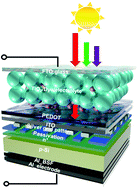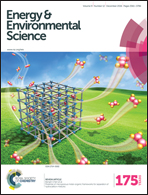Two-terminal DSSC/silicon tandem solar cells exceeding 18% efficiency†
Abstract
Tandem architectures using organic/inorganic hybrid semiconductors are a promising strategy to overcome the Shockley–Queisser limit of single-junction (SJ) solar cells as already demonstrated in III–V compound semiconductors. Here, we present a highly-efficient dye-sensitized solar cell (DSSC)/silicon (Si) monolithic tandem cell by utilizing PEDOT:FTS as an interfacial catalytic layer, which has higher transparency and lower charge-transfer resistance compared to conventional Pt. In addition, the amount of dye adsorbed on the surface of TiO2 nanoparticles is fine-tuned for precise current matching between the two sub-cells. Based on these rational approaches, the DSSC/Si tandem cell exhibited a much higher power-conversion efficiency (PCE) of 17.2% compared to the stand-alone SJ devices of DSSCs (−11.4%) or Si (−12.3%) cells. The PCE of the best tandem cell is 18.1%. To the best of our knowledge, our tandem cell has a record-high PCE among all tandem cells involving DSSCs and also the highest improvement of PCE among all tandem cells based on dissimilar photovoltaic materials. The 2-terminal DSSC/Si tandem solar cells exhibit a high Voc value of 1.36 V. The DSSC/Si tandem solar cells are externally connected to a Pt electro-catalyst for use as water splitting cells. Solar-to-hydrogen conversion was accomplished at 0.65 V vs. Pt bias. We expect that a tandem architecture based on organic–inorganic hybrid materials can provide a promising way to realize low-cost and high-efficiency photovoltaic devices for solar cells and hydrogen generation.


 Please wait while we load your content...
Please wait while we load your content...